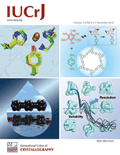
IUCrJ
Scope & Guideline
Exploring Interdisciplinary Connections in Crystallography
Introduction
Aims and Scopes
- Integration of Advanced Crystallographic Techniques:
The journal emphasizes the use of advanced techniques such as X-ray diffraction, electron diffraction, and cryo-electron microscopy to solve complex structural problems in macromolecules and materials. - Interdisciplinary Approaches to Structural Biology:
There is a strong focus on research that integrates structural biology with biochemistry, biophysics, and materials science, aiming to elucidate the relationship between structure and function in biological systems. - Development of Computational Methods:
The journal publishes studies on computational techniques for structure determination, such as molecular dynamics simulations, deep learning applications, and statistical modeling to enhance crystallographic analysis. - Exploration of Functional Materials:
Research on the design, synthesis, and characterization of functional materials, especially those with novel properties arising from their crystalline structure, is a core area of interest. - Data Archiving and Sharing:
The journal encourages the sharing of crystallographic data and the development of databases to support reproducibility and collaborative research in the field.
Trending and Emerging
- Application of Machine Learning in Crystallography:
There is a significant increase in studies utilizing machine learning techniques for crystal structure prediction, data analysis, and refinement, indicating a trend towards data-driven approaches in the field. - Time-Resolved and Dynamic Studies:
Research on time-resolved crystallography and dynamic structural studies is gaining traction, showcasing the ability to capture transient states and understand reaction mechanisms in real-time. - Integration of Structural Biology with Drug Development:
Emerging themes include the application of crystallographic techniques in drug discovery and development, particularly in understanding protein-ligand interactions and structure-based drug design. - High-Pressure and Extreme Conditions Studies:
There is an increasing interest in studying structural changes under high-pressure conditions, which provides insights into material properties and phase transitions. - Exploration of Soft Matter and Complex Systems:
Research on soft matter, including polymers, gels, and complex fluids, is becoming more prominent, reflecting the interdisciplinary nature of current crystallographic investigations.
Declining or Waning
- Traditional Crystallography Techniques:
There is a noted decrease in publications focused solely on traditional crystallographic methods without integration of modern techniques, as researchers increasingly adopt advanced imaging and computational approaches. - Studies on Inorganic Crystals:
Research specifically on simple inorganic crystal structures appears to have waned, as the field moves towards more complex organic-inorganic hybrid structures and materials with functional applications. - Static Structure Analysis:
Publications focusing exclusively on static analyses of crystal structures have decreased, with a growing emphasis on dynamic studies that explore structural changes under various conditions.
Similar Journals
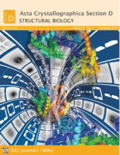
Acta Crystallographica Section D-Structural Biology
Connecting Crystallography with Biological UnderstandingActa Crystallographica Section D - Structural Biology is a premier academic journal published by the International Union of Crystallography, dedicated to advancing the field of structural biology. With an ISSN and E-ISSN of 2059-7983, this journal plays a crucial role in disseminating high-quality research, covering a wide spectrum of topics including crystallography, macromolecular structures, and their biological implications. Operating under a Q2 category ranking in the realm of structural biology, it highlights innovative and transformative studies that enhance our understanding of molecular architecture. The journal is notably indexed in Scopus, where it holds a rank of #28/49 in its category, placing it in the 43rd percentile. This robust positioning underscores its significance to the research community. With a reader base that includes leading scientists, professionals, and students in the biosciences, Acta Crystallographica Section D is integral for those looking to stay updated on cutting-edge discoveries in structural biology. The journal is available for readership and serves as a pivotal platform for researchers aiming to share their findings and contribute to the scientific dialogue.

Acta Crystallographica Section B-Structural Science Crystal Engineering and Materials
Bridging theory and application in structural science.Acta Crystallographica Section B: Structural Science, Crystal Engineering and Materials, published by the International Union of Crystallography, stands as a pivotal resource for researchers and professionals in the fields of materials science, crystal engineering, and structural biology. With an e-ISSN of 2052-5206, this journal is recognized for its contributions to advancing knowledge on the structural aspects of materials, drawing significant interest from the Q2 category in several disciplines, including Atomic and Molecular Physics and Materials Chemistry. As the field evolves through innovative research approaches and methodologies, the journal actively covers developments within the scope of materials synthesis, characterization, and application in various sectors including medicine and electronics. Though not an open-access journal, it is entangled in the scientific discourse, ensuring that key studies are accessible to academic institutions and professionals globally. With a commitment to excellence, its impact across multiple quartile rankings signifies its influence and importance for scholars eager to contribute to cutting-edge research.

Journal of Structural Biology-X
Empowering Discovery in Structural BiologyThe Journal of Structural Biology-X, published by Elsevier, is a leading open-access journal dedicated to advancing the field of structural biology. Launched in 2019, it has quickly established itself as a vital resource for researchers, professionals, and students, boasting a prestigious Q1 ranking in Structural Biology for 2023 and achieving an impressive Scopus rank of #19 out of 49 in the biochemistry, genetics, and molecular biology category. With an E-ISSN of 2590-1524, this journal emphasizes accessibility and collaboration by providing open access to its comprehensive collection of research articles, reviews, and cutting-edge methodologies. The scope of the journal encompasses significant themes within structural biology, including protein structure, molecular interactions, and imaging techniques, facilitating interdisciplinary dialogue and innovation. Join the global community of scientists and contribute to the body of knowledge that propels our understanding of molecular architecture through the Journal of Structural Biology-X.
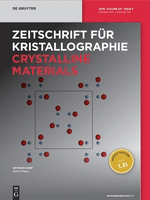
Zeitschrift fur Kristallographie-Crystalline Materials
Fostering Collaboration in the Realm of CrystallographyZeitschrift für Kristallographie-Crystalline Materials is a prestigious academic journal published by Walter de Gruyter GmbH, focusing on the intricate field of crystallography and its applications within condensed matter physics, inorganic chemistry, and materials science. Established in Germany, this journal spans a rich history from its inception in 1930 to its convergence years from 2012 to 2024, presenting cutting-edge research and developments in crystalline materials. With an impact factor reflective of its critical role within its field—ranking Q3 in the prestigious quartiles for 2023 across multiple categories—this journal serves as an essential platform for researchers, professionals, and students seeking to expand their knowledge and contribute to the advancement of crystalline materials. While currently not offering open access, the journal remains committed to disseminating high-quality, peer-reviewed articles that inspire innovation and collaboration within the scientific community.
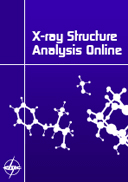
X-Ray Structure Analysis Online
Catalyzing Discoveries in Analytical and Materials ChemistryX-Ray Structure Analysis Online is a pivotal academic journal dedicated to the field of analytical and materials chemistry, published by the Japan Society for Analytical Chemistry. Established in 2009, this journal serves as a vital platform for researchers and professionals dedicated to advancing the understanding of X-ray structural analysis techniques and their applications. With ISSN 1883-3578, it operates under rigorous peer-review standards, promoting high-quality research contributions. While the journal is currently categorized in the Q4 quartile for both Analytical Chemistry and Materials Chemistry, its focus on cultivating a deeper understanding of material properties through X-ray analysis remains crucial for ongoing developments in these fields. By providing an accessible outlet for innovative studies, X-Ray Structure Analysis Online supports the academic community in overcoming the challenges of a rapidly evolving scientific landscape. It is particularly valuable for those engaged in material and analytical research, offering insights that contribute to both theoretical foundations and practical applications.

CRYSTENGCOMM
Fostering innovation through impactful research in crystal engineering.CRYSTENGCOMM is a distinguished journal published by the Royal Society of Chemistry, dedicated to advancing the field of crystallization and crystal engineering. With its impact factor consistently among the top tier in its category, CRYSTENGCOMM serves as an essential platform for researchers, professionals, and students in Chemistry, Condensed Matter Physics, and Materials Science. The journal has successfully maintained its relevance and influence since its inception, showcasing pioneering research from 1999 to 2024, with a commendable Q2 ranking in the latest evaluations. This accessibility to crucial developments in crystallization facilitates knowledge transfer across disciplines and enhances collaboration within the scientific community. Although it operates under a subscription model, the journal remains committed to disseminating cutting-edge research and fostering innovation in the field. For more information or to submit your research, please visit the Royal Society of Chemistry's website.

STRUCTURAL CHEMISTRY
Bridging Disciplines in Condensed Matter and ChemistrySTRUCTURAL CHEMISTRY is a premier journal published by SPRINGER/PLENUM PUBLISHERS, dedicated to advancing the study and understanding of the structural aspects of chemistry. With an ISSN of 1040-0400 and an E-ISSN of 1572-9001, this journal serves as a critical resource for researchers and professionals engaged in the fields of Condensed Matter Physics and Physical and Theoretical Chemistry. Since its inception in 1990, it has become an essential platform for disseminating high-quality research, featuring articles that explore innovative methodologies, experimental techniques, and theoretical frameworks. As evidenced by its Scopus rankings, including #192 in Condensed Matter Physics and #101 in Physical and Theoretical Chemistry, the journal occupies a respected position within the academic community, promoting interdisciplinary collaboration and insight. While it operates on a traditional subscription model, the journal continues to broaden its reach to foster knowledge exchange among scholars worldwide. With a commitment to excellence and relevance, STRUCTURAL CHEMISTRY remains a vital contributor to the scientific dialogue surrounding chemical structure and its myriad implications across various scientific disciplines.
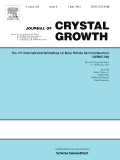
JOURNAL OF CRYSTAL GROWTH
Fostering Innovation in Materials ChemistryJOURNAL OF CRYSTAL GROWTH, published by Elsevier, stands as a vital platform in the realm of condensed matter physics, inorganic chemistry, and materials chemistry. With its inception dating back to 1967 and a promising convergence continuing through 2024, this journal encompasses the latest research and advancements in crystal growth phenomena. Although it does not currently offer open access options, its rigorous peer-review process ensures high-quality scholarly contributions that are essential for researchers, professionals, and students alike. The journal's solid standing is reflected in its Scopus rankings, with placements in the third and second quartiles across relevant fields and notable percentiles. Operating from the heart of the Netherlands, JOURNAL OF CRYSTAL GROWTH not only fosters academic dialogue but also enhances the understanding of crystallization processes crucial for materials engineering and applied sciences, making it an indispensable resource for anyone dedicated to exploring the intricacies of crystal growth.
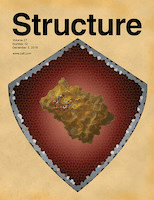
STRUCTURE
Exploring the molecular blueprints of life.STRUCTURE is a premier academic journal published by CELL PRESS, dedicated to advancing the field of structural biology and molecular biology since its inception in 1993. With an impressive reputation, it is recognized as a Q1 journal in both Molecular Biology and Structural Biology categories, reflecting its high impact within the academic community. The journal holds a significant position in Scopus rankings, placing 10th among 49 in Structural Biology and 100th among 410 in Molecular Biology, marking it as a key resource with a strong influence on ongoing research. Researchers and professionals alike will find STRUCTURE an invaluable platform for disseminating cutting-edge findings related to protein structure, dynamics, and interactions, fostering insights that can lead to groundbreaking applications in medicine and biotechnology. Although the journal follows a traditional subscription model, it continues to attract a diverse array of submissions, ensuring a vibrant exchange of knowledge in the ever-evolving landscape of structural and molecular biology. Access to its content can enhance the understanding of intricate biological mechanisms, making it essential reading for experts, students, and anyone passionate about the molecular underpinnings of life.

JOURNAL OF CHEMICAL CRYSTALLOGRAPHY
Advancing the frontiers of crystallographic research.Welcome to the Journal of Chemical Crystallography, a prominent publication dedicated to the advancement of knowledge in the fields of chemical crystallography, general chemistry, and condensed matter physics. Published by Springer/Plenum Publishers, this journal provides a critical platform for researchers, professionals, and students to disseminate and access innovative research findings and methodologies from 1994 to 2024. With an ISSN of 1074-1542 and E-ISSN 1572-8854, the journal currently holds a Q4 quartile ranking in both Chemistry and Condensed Matter Physics, reflecting its broadening scope and niche significance within the scientific community. While it operates under a traditional access model, it endeavors to promote high-quality research that advances theoretical and practical aspects of crystallography, making it an essential resource for those involved in these dynamic disciplines. Join us as we explore the intricate world of chemical structures and their properties, bridging gaps between chemistry and physics.